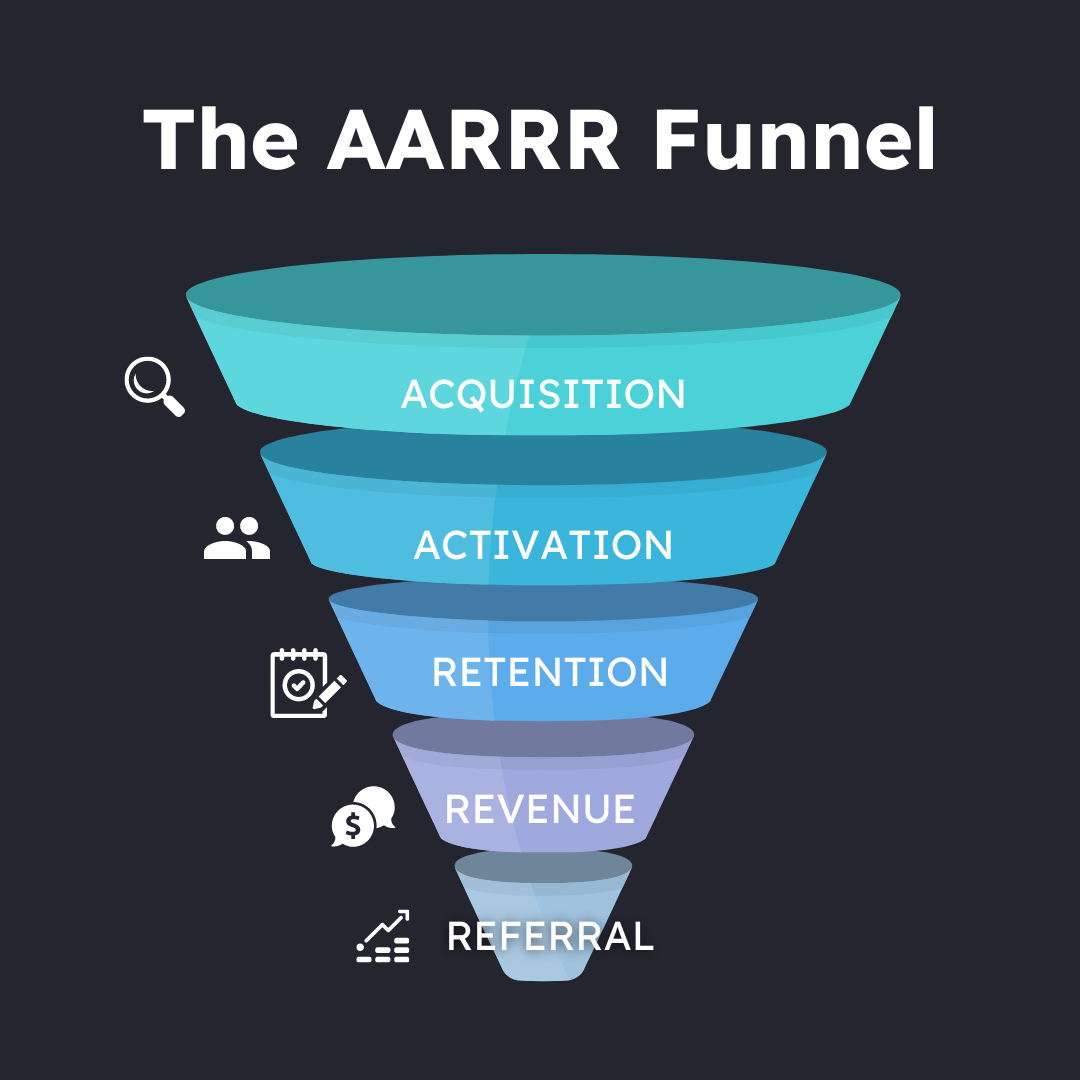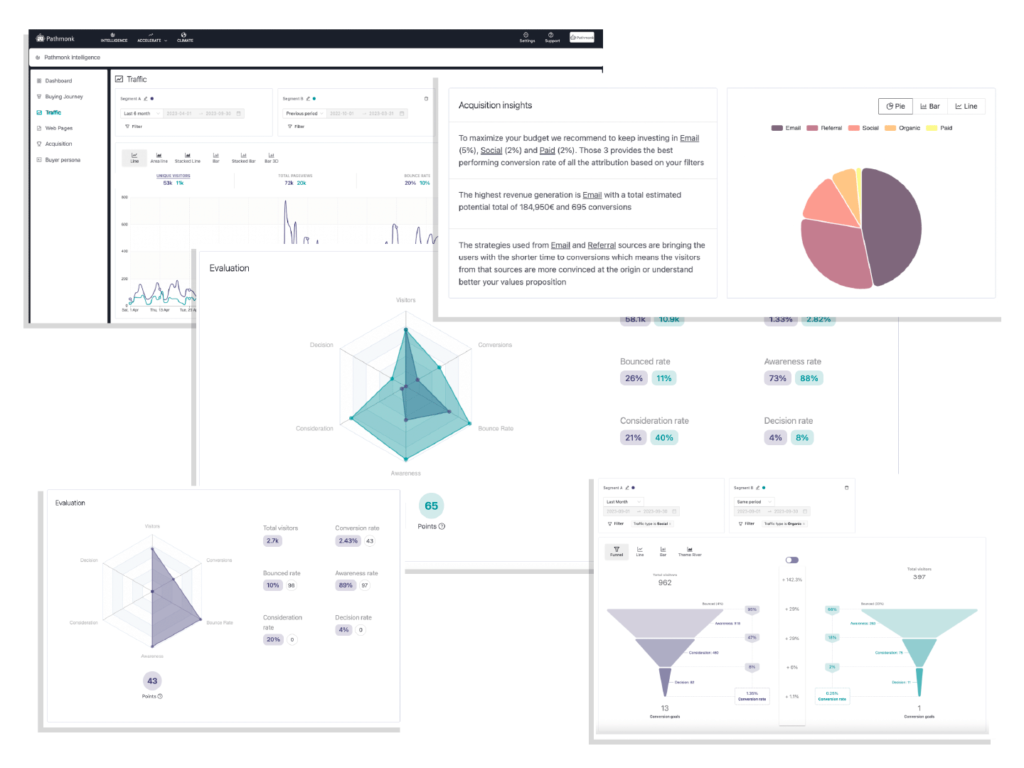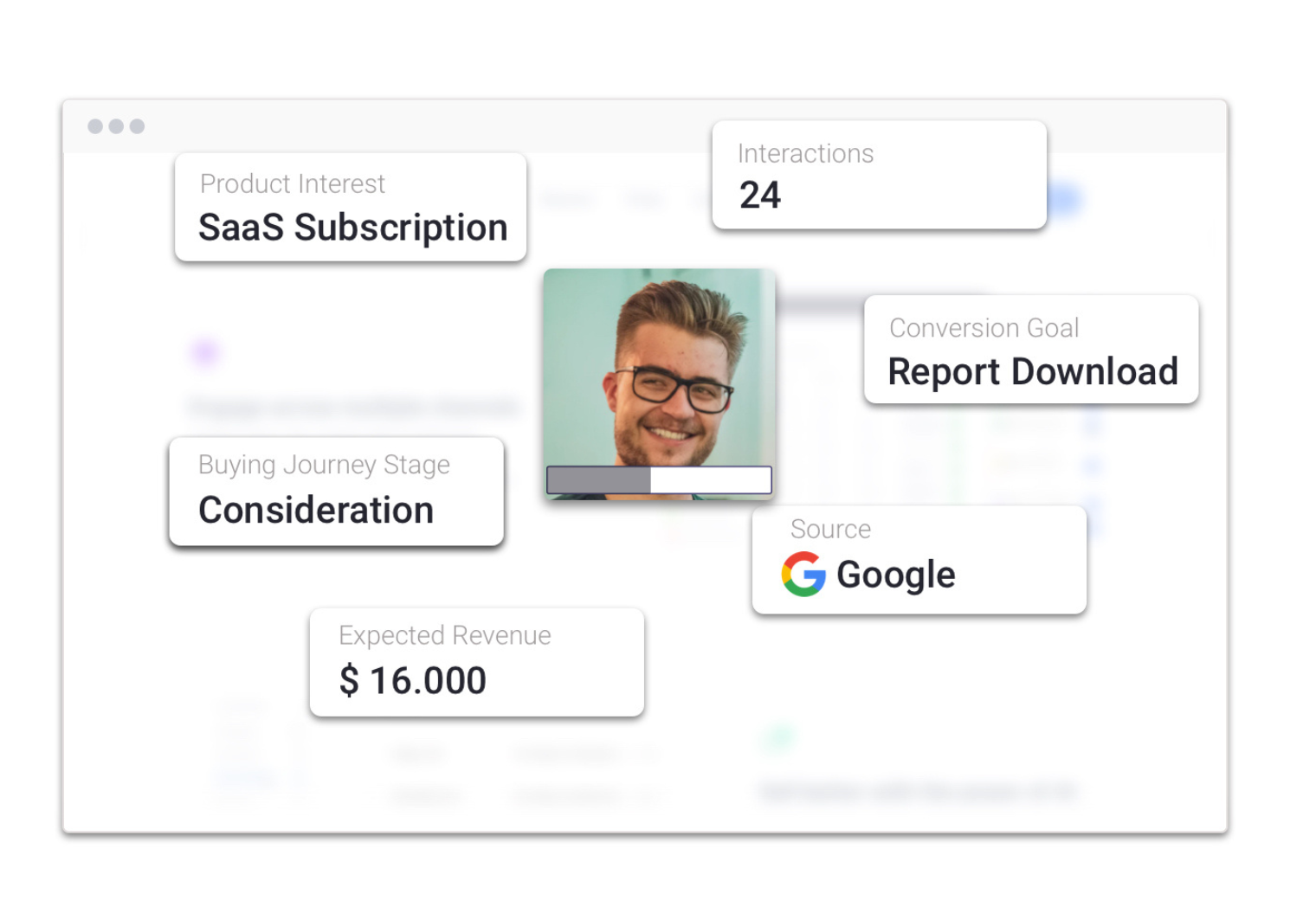What Is the Pirate Funnel? The AARRR Framework Explained


Nowadays, with so many distractions and over-saturated information, it is difficult to focus the shot. We want to be aware of so much data that measuring results ends up being a real disaster. That is why it is important to stop, take a step back, and reflect on what is really important for our business. And to help us with that, a wise man created the pirate funnel. The AARRR Pirate Framework is a compass that guides ventures through the murky depths of market engagement, conversion, and customer retention.
Table of Contents
This framework often hailed for its simplicity and effectiveness, has become an indispensable part of a marketer’s toolkit. And that’s why we are going to take the time to go stage by stage analyzing the particularities so that at the same time, you, -at home, or at the office, or in the cafeteria sucking the free wifi since early in the morning- can complete your template.
Download our free template and follow the steps to complete it without headaches!
What is the pirate funnel? Understanding the AARRR Framework
The Pirate Funnel, synonymous with the AARRR Framework, is a strategic approach to understanding and optimizing the customer journey. Its name, a playful nod to the sound a pirate makes, “Arrr!”, encapsulates the essence of the framework—Acquisition, Activation, Retention, Referral, and Revenue. This mnemonic aids marketers and entrepreneurs in focusing on the critical metrics that drive business growth.
Origins of the AARRR Framework

The AARRR Framework was coined by Dave McClure, a renowned entrepreneur, angel investor, and the founder of 500 Startups, in the mid-2000s. McClure’s extensive experience in the startup ecosystem led him to identify common patterns and challenges businesses face when trying to scale. He recognized the need for a simple, yet comprehensive, approach to customer lifecycle management that could be applied across various business models and industries.
The AARRR Framework emerged as a solution, offering a structured methodology for analyzing and optimizing the customer journey from initial contact through to a loyal, revenue-generating customer base.
Importance of the Framework in Today’s Marketing Landscape
The AARRR framework’s beauty lies in its simplicity and focuses on metrics that truly matter. In today’s digital age, the pirate funnel provides a clear and structured approach to understanding and optimizing the customer journey. Here’s why it’s more relevant than ever:
- Customer-Centric Approach: At its core, the AARRR framework emphasizes understanding and improving the user experience at every stage of the customer lifecycle. This aligns perfectly with today’s marketing ethos, where customer satisfaction is paramount.
- Data-Driven Decisions: The framework encourages marketers to rely on data to make informed decisions. By focusing on specific metrics at each stage, marketers can identify what works, what doesn’t, and where to invest their resources for the highest impact.
- Flexibility Across Industries: Whether you’re a startup, a multinational corporation, or anything in between, the AARRR framework is versatile enough to be applied across various industries and business models.
- Enhanced Collaboration: By providing a common language and set of goals, the AARRR framework enhances collaboration between different teams, from product development to sales and marketing.
- Focus on Growth: Ultimately, the framework is about growth—acquiring new users, retaining them, and maximizing revenue. In a competitive market, businesses that adeptly navigate these stages are the ones that thrive.
In conclusion, the AARRR Pirate Framework stands as a testament to the power of structured, data-driven approaches to marketing. It helps businesses understand their customer journey better and aligns their efforts towards achieving tangible growth.
The Five Stages of the Pirate Funnel AARRR Framework
Acquisition
Acquisition involves identifying and utilizing various channels to introduce potential customers to your product or service. The primary goal is to convert unaware individuals into visitors or users by capturing their attention and directing them to your platform. It’s about making your presence known in the crowded marketplace and standing out to your target audience.
Key Metrics for Measuring Acquisition
The effectiveness of acquisition efforts is often measured by the following key metrics:
- Customer Acquisition Cost: The total cost of acquiring a new customer, including all marketing and sales expenses.
- Traffic: The number of visitors to your website or users of your app.
- Conversion Rate: The percentage of visitors who take a desired action, such as signing up for a trial or making a purchase.
- Channel Efficiency: The effectiveness of different acquisition channels in terms of cost and conversion rate.
Challenges Faced in This Stage
Businesses encounter several challenges during the acquisition phase, including:
- High Competition: Standing out in a saturated market where competitors are vying for the same audience’s attention.
- Rising Acquisition Costs: Efficiently managing the budget as the cost of acquiring new customers continues to increase.
- Choosing the Right Channels: Identifying the most effective channels for reaching the target audience among the plethora of available options.
- Measuring Effectiveness: Accurately tracking and attributing conversions to the correct acquisition efforts.
Strategies
Pathmonk Intelligence stands as a cutting-edge solution designed to enhance and optimize the acquisition stage of the AARRR Pirate Funnel. As businesses grapple with the challenges of attracting new customers in a highly competitive digital landscape, Pathmonk offers a suite of tools that leverage artificial intelligence to streamline and elevate the acquisition process. Here’s how Pathmonk Intelligence can significantly contribute to this stage:
Personalized User Experiences
Pathmonk Intelligence utilizes AI to analyze user behavior in real-time, allowing for the creation of personalized user experiences. By understanding what a visitor is most likely interested in, based on their interaction with your website, Pathmonk can dynamically adjust content, messages, and calls-to-action to match the visitor’s preferences and intent. This personalization helps in engaging visitors more effectively, increasing the likelihood of conversion from casual browsers to interested prospects.
Optimizing Conversion Paths
One of the key capabilities of Pathmonk is its ability to optimize conversion paths on your website. It identifies the most efficient routes that lead users towards making a purchase or signing up for a service. By analyzing data points such as page views, time spent on pages, and interaction with specific content, Pathmonk suggests and implements improvements that can make the journey toward conversion smoother and more intuitive for users.
Enhanced Lead Qualification
Pathmonk Intelligence goes beyond just attracting traffic; it helps in qualifying leads by analyzing user behavior and engagement levels. By prioritizing visitors who show a higher intent to purchase or sign up, Pathmonk enables businesses to focus their efforts and resources on leads that are more likely to convert, thus improving the efficiency of the Acquisition stage.
Insights and Analytics
Pathmonk provides valuable insights and analytics that allow businesses to understand their acquisition efforts better. By tracking the performance of various pages and content in real time, businesses can identify what works best for attracting and engaging potential customers. These insights can then be used to refine strategies, content, and campaigns, ensuring that acquisition efforts are data-driven and optimized for the best results.
Intuitive Cookieless Analytics for Your Web
Understand your customer journey, find drop-offs, and receive actionable insights with AI.

Examples
Dropbox: Dropbox famously used a referral program as part of its acquisition strategy, offering additional storage space to users who referred their friends. This not only reduced their CAC but also virally increased their user base.
Airbnb: Airbnb leveraged Craigslist integration to acquire users by allowing property listers on Airbnb to post their listings on Craigslist as well, significantly increasing their visibility and user base.
Activation
The activation stage is a crucial phase within the pirate funnel, where businesses focus on converting newly acquired visitors into active users who see the value in their offerings. This stage is about making a great first impression and engaging users so they take the desired actions, such as signing up, making a purchase, or using a key feature of your product or service. Here’s how businesses can navigate the activation stage, measure success, tackle challenges, and implement strategies for improvement, with a special focus on how Pathmonk Accelerate can be a game-changer in this process.
Key Metrics for Measuring Activation
- Activation Rate: The percentage of users who take a desired action upon their first visit. This could be signing up for a trial, creating an account, or making a first purchase.
- Time to Activation: The average time it takes for a new user to reach the “activated” state. Shorter times are generally better, indicating a seamless user journey.
- User Engagement: Metrics that indicate how users are interacting with your product, such as session duration, pages visited, and features used.
Challenges Faced in This Stage
- Traffic that doesn’t convert: Many businesses struggle with visitors who browse their websites but leave without taking any significant action. This could be due to unclear value propositions, a complicated sign-up process, or simply not meeting the user’s expectations.
- User Onboarding Complexity: Complex or lengthy onboarding processes can significantly reduce activation rates. Users who find the initial setup or learning curve too steep may abandon the process before realizing the product’s value.
- Lack of Immediate Value Perception: Users need to quickly perceive the value of a product or service to become activated. If the benefits are not immediately clear or if the user has to navigate through multiple steps before experiencing the core features, their likelihood of disengagement increases.
- Poor Mobile Experience: With an increasing number of users accessing websites and applications via mobile devices, a poor mobile experience can significantly impact activation rates.
Strategies
Pathmonk Accelerate offers powerful solutions to enhance the activation stage by employing AI-driven insights and optimizations. Incorporating Pathmonk Accelerate into the activation stage of the pirate funnel can significantly improve how businesses convert passive visitors into active users. By leveraging AI to personalize experiences, streamline user journeys, and make real-time adjustments, Pathmonk Accelerate helps businesses overcome common challenges in this stage, ensuring a higher rate of user activation and engagement. Here’s how it can help:
Personalization
Pathmonk Accelerate can dynamically adjust the content, messages, and CTAs presented to each visitor based on their behavior and preferences, making the value proposition clearer and more compelling.
Simplifying the User Journey
By analyzing user behavior, Pathmonk Accelerate identifies friction points within the activation process and suggests optimizations to make the journey toward activation smoother and more intuitive.
Real-Time Adjustments
Pathmonk’s AI capabilities allow for real-time adjustments to website elements, ensuring that potential customers are more likely to engage and take the desired actions.
Examples
Spotify: uses its free trial to activate new users. By offering immediate access to premium features, Spotify ensures users experience the full value of its service right away, encouraging them to become paying subscribers.
Dropbox: activates users by offering extra storage for completing the onboarding process. This immediate, tangible reward encourages new users to engage with key features, effectively demonstrating the product’s value.
Retention
The retention stage is a crucial component of the funnel, emphasizing the importance of keeping customers engaged and active over time. After successfully acquiring and activating users, retaining them becomes essential for sustained growth and profitability. In this stage, businesses focus on creating lasting relationships with their customers, encouraging repeat usage and interactions with the product or service.
Key Metrics for Measuring Retention
- Customer Retention Rate: Measures the percentage of customers who remain active over a given period.
- Churn Rate: The percentage of customers who stop using your product or service within a certain timeframe.
- Repeat Purchase Rate: For e-commerce, this indicates how often customers make subsequent purchases.
- Engagement Metrics: Include daily/monthly active users, session length, and frequency of use, showing how engaged users are with your product.
Challenges Faced in This Stage
- High Churn Rate: Businesses often struggle with customers discontinuing their use of the product after a short period, indicating dissatisfaction or a failure to see ongoing value.
- Customer Feedback Loop: Establishing an effective feedback loop to understand why customers are leaving can be challenging, yet it’s crucial for addressing underlying issues.
- Engagement Drop-off: Even active users might gradually use the product less frequently over time, signaling a waning interest or relevance of the product.
- Competitive Offerings: Customers are constantly bombarded with alternatives. Standing out and retaining customer loyalty in a competitive market can be a daunting task.
Strategies
Personalized Engagement
Use data analytics to personalize communication and offers based on user behavior and preferences, enhancing the perceived value of your product.
Quality Content and Updates
Regularly update your product with new features and content that address user needs and feedback, keeping the offering fresh and relevant.
Loyalty Programs
Implement loyalty or rewards programs that incentivize repeat usage and deepen customer commitment to your product.
Proactive Customer Support
Offer proactive, accessible customer support to address issues before they lead to churn, improving overall customer satisfaction.
Examples
Netflix: Netflix keeps users engaged by continuously updating its content library and using sophisticated algorithms to recommend personalized content, significantly reducing churn.
Spotify: Spotify uses data-driven personalization to create custom playlists and new music recommendations, encouraging daily app engagement and long-term retention.
Revenue
The revenue stage is a critical phase in the AARRR funnel where the focus shifts to generating meaningful income from the user base that has been acquired, activated, and retained. This stage is about optimizing monetization strategies without compromising the user experience. Understanding the key metrics, identifying challenges, and implementing effective strategies are essential steps in maximizing revenue while maintaining customer satisfaction.
Key Metrics for Measuring Revenue
- Average Revenue Per User: Measures the average income generated from each active customer over a specific period.
- Customer Lifetime Value: Estimates the total revenue a business can expect from a single customer account throughout their relationship with the company.
- Conversion Rate: The percentage of users who make a purchase or subscribe to a service out of the total number of visitors or users.
- Revenue Growth Rate: Measures the rate at which a company’s income, from sales or services, is increasing over time.
Challenges Faced in This Stage
- Increasing Competition: In many markets, the abundance of alternatives can make it difficult for businesses to justify their value proposition and pricing, affecting revenue.
- Price Sensitivity: Users may be reluctant to pay for a service or product if they perceive it as too expensive or if there’s a free alternative available.
- Upselling/Cross-selling Efficiency: Finding the right balance in promoting additional purchases without alienating users can be challenging.
- Maintaining Value Perception: As users become more familiar with your product or service, maintaining or increasing their perception of its value over time to justify ongoing or higher costs is crucial.
Strategies
Value-Based Pricing
Implement pricing strategies that reflect the perceived value of your product or service to different customer segments.
Freemium to Premium Conversion
Offer a freemium model that provides basic value for free while encouraging upgrades to premium versions for advanced features.
Bundling and Cross-Selling
Introduce product bundles or complementary services that enhance the user experience, encouraging additional purchases.
Loyalty and Referral Programs
Implement programs that reward users for their loyalty and for referring new customers, indirectly boosting revenue.
Examples
Adobe: successfully transitioned from selling perpetual licenses for its software to a subscription-based model with Adobe Creative Cloud, significantly increasing its revenue by offering ongoing value through constant updates and cloud services.
Dropbox: employs a freemium model that encourages users to start with a free, limited storage plan and then upgrade to premium plans for more storage and features, effectively increasing ARPU.
Referral
The referral stage is an integral part of the Pirate Funnel, focusing on leveraging satisfied customers to drive new user acquisition through word-of-mouth and recommendations. This stage amplifies the effectiveness of the marketing efforts by turning users into brand advocates.
Key Metrics for Measuring Referral
- Net Promoter Score: Measures customer willingness to recommend a product or service to others, indicating overall customer satisfaction and loyalty.
- Referral Rate: The percentage of customers who refer new users to your product or service.
- Viral Coefficient: Indicates how many new users, on average, each existing user is able to bring to your product.
- Customer Lifetime Value Increase: Assessing the increase in CLTV due to referrals can indicate the long-term value of referral-driven customers.
Challenges Faced in This Stage
- Encouraging Referrals: Motivating satisfied customers to actively refer others can be challenging without the right incentives or mechanisms in place.
- Tracking and Attribution: Properly attributing referrals to the correct source and understanding the effectiveness of different referral channels can be complex.
- Maintaining Quality: Ensuring that the influx of new users through referrals matches the target audience and maintains the quality of the user base.
- Offering Compelling Incentives: Designing incentives that are attractive enough to encourage referrals, yet sustainable for the business, requires careful consideration.
Strategies
Implement Referral Programs
Create structured referral programs that offer rewards or incentives for both the referrer and the referred, making it a win-win situation.
Leverage Social Proof
Showcase testimonials, user reviews, and success stories to build trust and encourage referrals.
Simplify the Referral Process
Make the process of referring as easy as possible with shareable links, referral codes, and straightforward instructions.
Personalize the Referral Experience
Tailor referral messages, emails, and offers to fit the individual user, making them more likely to engage and share with their network.
Examples
Dropbox: their referral program famously gave extra storage space to both the referrer and the referred, significantly increasing its user base.
Uber: provides credits to both the referrer and the new user, incentivizing current users to invite their friends and family to try the service.
Conclusions
In applying the AARRR framework, businesses are equipped to identify key metrics that matter, understand the challenges at each stage, and implement targeted strategies to overcome these obstacles. Whether it’s leveraging tools like Pathmonk for smarter acquisition and activation or designing compelling referral programs, the focus remains on driving sustainable growth and building a loyal customer base.
The pirate funnel is more than just a marketing model; it’s a philosophy that places the customer journey at the heart of business growth strategies. By focusing on creating a seamless, engaging, and value-driven experience for customers at every touchpoint, companies can not only achieve their growth targets but also build a strong, sustainable brand in a competitive market landscape.






